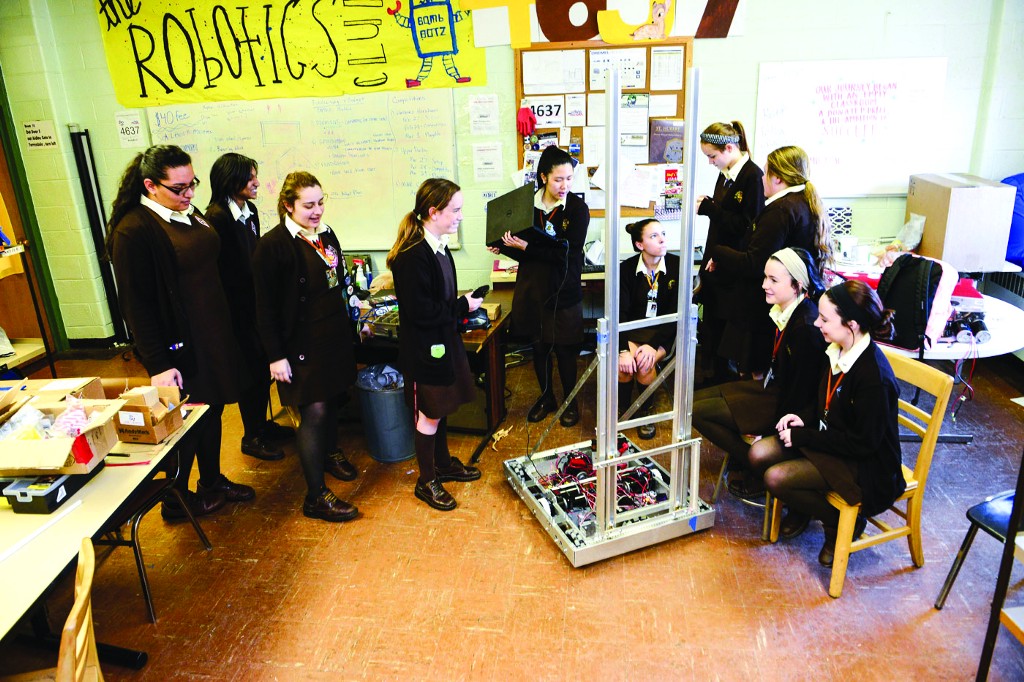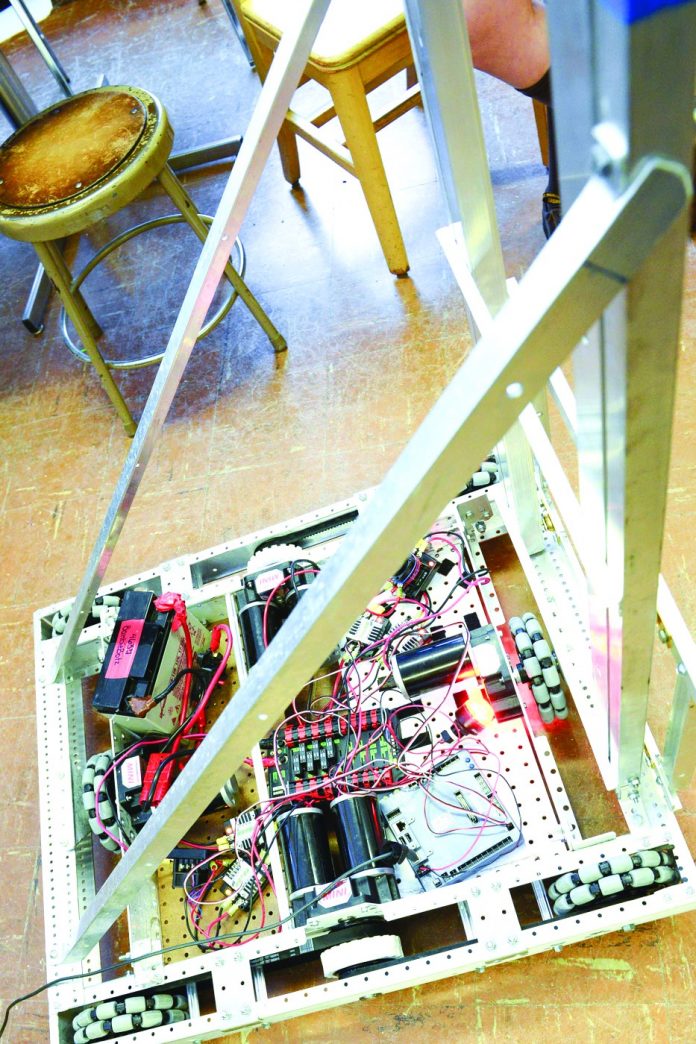Ready to build: The BambieBotz lab is a standard classroom where desks have been replaced with workbenches. Team members operate a band saw, circular saw, drill press, socket wrenches and countless other gadgets.
They said they were building a robot, this collection of brown jumper-wearing and ponytail-wagging Bambies. Problem is, their device contradicts any robot that we’ve ever seen.
It has no bionic arms or legs, no microwave antennas protruding from a humanoid head. The chassis is not cloaked in shiny plates of tin. It doesn’t even make funny noises, at least not yet.
But the ladies of the robotics team at St. Hubert Catholic High School for Girls, who call themselves the BambieBotz in tribute to their school’s Disneyfied mascot, have a plan. Their work has nothing to do with Hollywood and even less to do with a group of people who traditionally corner the market on sci-fi fantasy — the boys.
“We are like ten times less stylish than the boys teams,” freshman Ryan Doherty said confidently when asked about the lack of bells and whistles on their machine.
Nicole Moore, a junior, said that the BambieBotz are going for function over form: “As long as it functions properly and gets the job done.”
For the third consecutive year, St. Hubert students are tackling a very specific job as part of the FIRST Robotics Competition, an international program founded in New Hampshire in 1989 that has grown to involve about 75,000 high schoolers. This year’s theme, “Recycle Rush,” calls upon teams to build a robot that can rearrange recycle containers and collect pool noodles meant to simulate scattered debris.
Although still relatively new to FIRST Robotics, the BambieBotz are no greenhorns. During their first season, they made it all the way to the national championships in St. Louis and garnered the “Rookie All-Stars” award. They followed that up with another solid entry last year.
But they’re ramping up their game in 2015 with the addition of Comcast NBCUniversal’s Jeanine Heck, a St. Hubert alumna who works as a project manager for the mass media colossus. Heck brings her engineering expertise — that’s what she studied at Penn — her corporate acumen and her feminine mentorship to a group looking to eradicate lingering 20th-century stereotypes.
“This is a way that I can personally have an impact on female engineering. (On the professional level) I would really like to see more women in the room,” Heck said during a recent “build” session in the BambieBotz robotics lab.
According to St. Hubert President Frank Farrell, the gender gap affects high schools, too. Only about 10 percent of all FIRST Robotics participants are girls, Farrell said. Junior Ashley Sanchez has seen that phenomena first-hand. At competitions, boys outnumber the girls by a wide margin and dominate the high-profile roles, such as operating the remote control, although most teams are co-ed officially.
“There are definitely more guys, especially on the drive teams and in the ‘pit,’” Sanchez said.
That’s obviously not the case at St. Hubert, an all-girls school with an enrollment of 639.
“They’re really inspiring to me. I’m almost filled with tears watching them demonstrate their robot,” Heck said
The BambieBotz lab is a standard classroom where desks have been replaced with workbenches and chalkboards with tool racks. According to physics teacher Wayne Flood, who moderates the extracurricular program, everything they use comes via donations. The team includes about 20 students grades nine through 12 who operate a band saw, circular saw, drill press, socket wrenches and countless other gadgets usually found in garages, machine shops and construction sites.
Moore, the 11th-grader, said that they want their robot to be mobile and precise because it will have to pick up, move and stack rectangular bins as well as round barrels. During competitions, each completed task will earn the team points.
To that end, the robot has an “H-drive” platform allowing it to move forward, backward and laterally. It also has a forklift on the front to grab and raise the recycle containers. In keeping with the FIRST Robotics Competition format, the robot must employ standard innerworkings as specified by the sanctioning organization. A motorcycle battery supplies the power while several motors and electronic systems give it motion.
During some phases of competition, selected team members known as drivers control the robots remotely. For other phases, the machines run autonomously based on pre-programmed behaviors.
The BambieBotz, much like the other 3,000 or so teams entered, are wrapping up a six-week development period in preparation for the competition season. At this stage, they spend about 18 hours a week on the project, working after school and on Saturdays. Even then, they always seem pressed for time.
“You have to be strategic in what you do,” said Heck, who was a cheerleader and a mathlete in high school.
“You want to focus on what gets the most points for your team,” Moore agreed.
Organization is key. Heck, who is one of about 100 Comcast NBCUniversal employees mentoring in the FIRST program this year, has brought a new professionalism to the BambieBotz. Much like a corporation, they employ a system of committees that specialize in various aspects of the project, including programming (writing Java code), electrical and mechanical.
“We all come up with ideas and decide which would be most efficient. Then we bring them together and decide on the perfect design,” Moore said.
Even so, a lot of the engineering evolves through troubleshooting and modification; in other words, trial and error.
“We have it all worked out, but when we make the good copy, we have to be more accurate,” Doherty said.
Outside of production duties, the team also has a group that interprets the rules of the competition. Yet another group works on marketing efforts, such as publicity, Web presence and social media.
“We need to market ourselves to get sponsors, to get mentors and for recruiting,” Flood said.
Heck has been working closely with sophomore Maddie Betzner and the fundraising committee to develop the team’s financial plan. In the past, money was never really a big concern for them because, frankly, they didn’t have very much. They still don’t, to be honest. But they’ll need to put financial controls in place as their fundraising efforts grow. Under the FIRST Robotics rules, teams can invest only so much in their machines. In addition, entry fees and travel expenses are costly.
“We made a list of our goals and what we’d use the money for,” Heck said.
The team effort transcends the students, their faculty adviser and mentor. It has become a family affair with parents, siblings and team alumni lending their diverse talents to the project. Sophomore twins Angela and Kristina Hampson come from a long line of mechanical engineers. Their dad and uncle both practice the profession. Elder sister Jessica was on the first BambieBotz two years ago. She’s now a mechanical engineering major at Temple.
“My dad comes almost every Saturday and sometimes during the week,” Kristina said.
“My dad works five days a week. I don’t get to see him a lot during the weekdays, so this is a good chance to spend time with him,” Angela said.
Other parents help in less technical ways. Sanchez’ mom cooked a dinner of rice gandules and barbecue wings for the team to enjoy during one evening session at the lab. The team hopes other families will follow that lead.
For some Bambies, that kind of bonding and friendship are more attractive than the robot-building. Junior Sydney Williams has no intention of becoming an engineer. Rather, she wants to study film production after high school, but she signed up for the BambieBotz anyway.
“People told me it was really fun and a community-type thing,” Williams said.
Other participants, like the Hampsons and sophomore Ashley Wallace, have technical work in their blood.
“My dad’s a machinist so growing up I always did stuff with him. That’s how I got into it,” Wallace said. “It’s been male-dominated, but there’s more women now.”
The boys better be ready for the challenge. ••

Girl power: Members of the St. Hubert Catholic High School robotics team will once again compete in the FIRST Robotics Competition. This year’s theme, “Recycle Rush,” calls upon teams to build a robot that can rearrange recycle containers. According to physics teacher Wayne Flood, who moderates the extracurricular program, everything they use comes via donations. MARIA POUCHNIKOVA / TIMES PHOTOS





